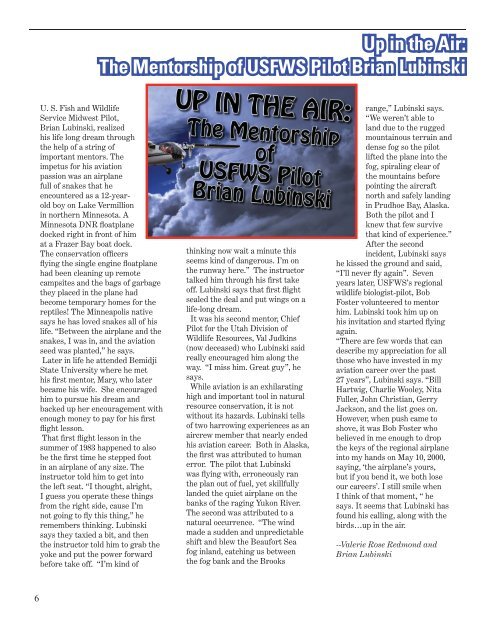Inside Region 3 - U.S. Fish and Wildlife Service
Inside Region 3 - U.S. Fish and Wildlife Service
Inside Region 3 - U.S. Fish and Wildlife Service
Create successful ePaper yourself
Turn your PDF publications into a flip-book with our unique Google optimized e-Paper software.
6<br />
Up in the Air:<br />
The Mentorship of USFWS Pilot Brian Lubinski<br />
U. S. <strong>Fish</strong> <strong>and</strong> <strong>Wildlife</strong><br />
<strong>Service</strong> Midwest Pilot,<br />
Brian Lubinski, realized<br />
his life long dream through<br />
the help of a string of<br />
important mentors. The<br />
impetus for his aviation<br />
passion was an airplane<br />
full of snakes that he<br />
encountered as a 12-yearold<br />
boy on Lake Vermillion<br />
in northern Minnesota. A<br />
Minnesota DNR fl oatplane<br />
docked right in front of him<br />
at a Frazer Bay boat dock.<br />
The conservation officers<br />
fl ying the single engine fl oatplane<br />
had been cleaning up remote<br />
campsites <strong>and</strong> the bags of garbage<br />
they placed in the plane had<br />
become temporary homes for the<br />
reptiles! The Minneapolis native<br />
says he has loved snakes all of his<br />
life. “Between the airplane <strong>and</strong> the<br />
snakes, I was in, <strong>and</strong> the aviation<br />
seed was planted,” he says.<br />
Later in life he attended Bemidji<br />
State University where he met<br />
his first mentor, Mary, who later<br />
became his wife. She encouraged<br />
him to pursue his dream <strong>and</strong><br />
backed up her encouragement with<br />
enough money to pay for his fi rst<br />
fl ight lesson.<br />
That fi rst fl ight lesson in the<br />
summer of 1983 happened to also<br />
be the fi rst time he stepped foot<br />
in an airplane of any size. The<br />
instructor told him to get into<br />
the left seat. “I thought, alright,<br />
I guess you operate these things<br />
from the right side, cause I’m<br />
not going to fl y this thing,” he<br />
remembers thinking. Lubinski<br />
says they taxied a bit, <strong>and</strong> then<br />
the instructor told him to grab the<br />
yoke <strong>and</strong> put the power forward<br />
before take off. “I’m kind of<br />
thinking now wait a minute this<br />
seems kind of dangerous. I’m on<br />
the runway here.” The instructor<br />
talked him through his first take<br />
off. Lubinski says that fi rst fl ight<br />
sealed the deal <strong>and</strong> put wings on a<br />
life-long dream.<br />
It was his second mentor, Chief<br />
Pilot for the Utah Division of<br />
<strong>Wildlife</strong> Resources, Val Judkins<br />
(now deceased) who Lubinski said<br />
really encouraged him along the<br />
way. “I miss him. Great guy”, he<br />
says.<br />
While aviation is an exhilarating<br />
high <strong>and</strong> important tool in natural<br />
resource conservation, it is not<br />
without its hazards. Lubinski tells<br />
of two harrowing experiences as an<br />
aircrew member that nearly ended<br />
his aviation career. Both in Alaska,<br />
the first was attributed to human<br />
error. The pilot that Lubinski<br />
was flying with, erroneously ran<br />
the plan out of fuel, yet skillfully<br />
l<strong>and</strong>ed the quiet airplane on the<br />
banks of the raging Yukon River.<br />
The second was attributed to a<br />
natural occurrence. “The wind<br />
made a sudden <strong>and</strong> unpredictable<br />
shift <strong>and</strong> blew the Beaufort Sea<br />
fog inl<strong>and</strong>, catching us between<br />
the fog bank <strong>and</strong> the Brooks<br />
range,” Lubinski says.<br />
“We weren’t able to<br />
l<strong>and</strong> due to the rugged<br />
mountainous terrain <strong>and</strong><br />
dense fog so the pilot<br />
lifted the plane into the<br />
fog, spiraling clear of<br />
the mountains before<br />
pointing the aircraft<br />
north <strong>and</strong> safely l<strong>and</strong>ing<br />
in Prudhoe Bay, Alaska.<br />
Both the pilot <strong>and</strong> I<br />
knew that few survive<br />
that kind of experience.”<br />
After the second<br />
incident, Lubinski says<br />
he kissed the ground <strong>and</strong> said,<br />
“I’ll never fl y again”. Seven<br />
years later, USFWS’s regional<br />
wildlife biologist-pilot, Bob<br />
Foster volunteered to mentor<br />
him. Lubinski took him up on<br />
his invitation <strong>and</strong> started flying<br />
again.<br />
“There are few words that can<br />
describe my appreciation for all<br />
those who have invested in my<br />
aviation career over the past<br />
27 years”, Lubinski says. “Bill<br />
Hartwig, Charlie Wooley, Nita<br />
Fuller, John Christian, Gerry<br />
Jackson, <strong>and</strong> the list goes on.<br />
However, when push came to<br />
shove, it was Bob Foster who<br />
believed in me enough to drop<br />
the keys of the regional airplane<br />
into my h<strong>and</strong>s on May 10, 2000,<br />
saying, ‘the airplane’s yours,<br />
but if you bend it, we both lose<br />
our careers’. I still smile when<br />
I think of that moment, “ he<br />
says. It seems that Lubinski has<br />
found his calling, along with the<br />
birds…up in the air.<br />
--Valerie Rose Redmond <strong>and</strong><br />
Brian Lubinski

















